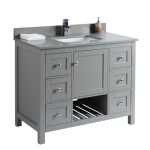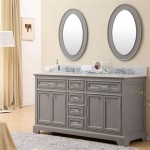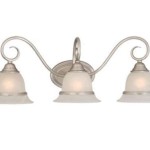Bathroom Vanity With Concrete Top: A Durable and Stylish Choice
The bathroom vanity serves as a focal point in the bathroom, offering practical storage solutions while contributing significantly to the overall aesthetic. Among the diverse materials available for vanity countertops, concrete has emerged as a popular choice, appreciated for its durability, versatility, and modern appeal. A bathroom vanity with a concrete top can transform a bathroom into a stylish and functional space.
Concrete, traditionally associated with construction and industrial settings, has found its place in interior design. Its inherent strength and adaptability make it suitable for bathroom applications, enduring the challenges of moisture, temperature fluctuations, and daily use. Concrete surfaces also offer a range of customization options, allowing homeowners to achieve a unique and personalized look.
Selecting a bathroom vanity with a concrete top involves careful consideration of several factors, including the type of concrete, the finish, the dimensions, and the overall design of the bathroom. A well-chosen concrete countertop can become a lasting investment, enhancing the value and appeal of the home.
Durability and Longevity of Concrete Vanity Tops
The resilience of concrete is one of its primary advantages as a countertop material. Unlike some natural stones or manufactured surfaces, concrete is remarkably resistant to scratches, heat, and chipping. While it is not impervious to these damages, concrete can endure the rigors of a busy bathroom environment with proper care and maintenance.
The strength of a concrete countertop is directly related to the concrete mix used in its fabrication. A well-formulated mix, incorporating high-quality cement, aggregates, and additives, results in a dense and robust material. The curing process, during which the concrete hardens and gains strength, is equally crucial. Proper curing ensures the concrete achieves its maximum potential strength and durability.
To further enhance the durability of a concrete vanity top, sealants are typically applied. These sealants penetrate the concrete surface, creating a protective barrier against water, stains, and chemicals. The type of sealant used can vary depending on the desired finish and the level of protection required. Regular reapplication of sealant is necessary to maintain the integrity of the protective layer.
While concrete is inherently strong, it is also somewhat porous. Without proper sealing, liquids can penetrate the surface, leading to staining and discoloration. Promptly cleaning up spills and avoiding harsh chemicals are essential practices for preserving the appearance and longevity of a concrete vanity top.
The long-term cost-effectiveness of a concrete vanity top lies in its durability and reduced need for replacement. While the initial investment might be comparable to other countertop materials, the extended lifespan and minimal maintenance requirements can make it a financially sound choice over time.
Design Flexibility and Aesthetic Appeal
Beyond its functional advantages, concrete offers remarkable design flexibility, allowing for a wide array of aesthetic possibilities. Unlike some pre-fabricated countertop materials with limited design options, concrete can be customized to suit diverse bathroom styles.
One of the most significant advantages of concrete is its ability to be cast into virtually any shape or size. This allows for seamless integration with custom cabinetry, creating a cohesive and visually appealing bathroom design. Integrated sinks, drainboards, and other features can be incorporated directly into the concrete countertop, eliminating seams and creating a streamlined appearance.
Concrete can be colored using various pigments, offering a spectrum of hues from subtle neutrals to bold, vibrant tones. The color is typically added to the concrete mix before casting, ensuring a uniform and consistent coloration throughout the countertop. Color matching to existing bathroom fixtures and decor is readily achievable.
The finish applied to a concrete vanity top plays a crucial role in its overall aesthetic. Polished concrete provides a smooth, glossy surface that reflects light and enhances the sense of space. Honed concrete, on the other hand, offers a matte finish with a more natural and understated look. Textured finishes, such as exposed aggregate or troweled surfaces, add visual interest and tactile appeal.
Concrete's natural variations, such as subtle color differences and surface imperfections, contribute to its unique character. These imperfections are not flaws but rather inherent qualities that enhance the material's authenticity and charm. Many homeowners appreciate these variations as evidence of the concrete's handmade nature.
The versatility of concrete extends to its ability to be combined with other materials. Inlays of stone, glass, or metal can be incorporated into the concrete surface, creating intricate and personalized designs. The juxtaposition of concrete with other materials adds depth and visual interest to the bathroom vanity.
Installation and Maintenance Considerations
Proper installation is crucial for the performance and longevity of a concrete vanity top. Due to its weight and size, concrete countertops typically require professional installation. Experienced installers possess the knowledge and skills necessary to handle the material safely and ensure a level and secure installation.
Before installation, the vanity cabinet must be adequately reinforced to support the weight of the concrete top. Concrete is significantly heavier than many other countertop materials, and inadequate support can lead to cracking or structural damage. The installer will assess the cabinet's structural integrity and recommend appropriate reinforcement measures if necessary.
During installation, the concrete countertop is carefully leveled and secured to the vanity cabinet using adhesives and fasteners. The seams between the countertop and the wall or adjacent surfaces are typically filled with a flexible sealant to prevent water damage. The installer will also ensure that the plumbing connections are properly aligned and sealed.
Once installed, a concrete vanity top requires ongoing maintenance to preserve its appearance and protect it from damage. Regular cleaning with a mild soap and water solution is generally sufficient for removing everyday dirt and grime. Avoid using abrasive cleaners or scouring pads, as these can scratch or dull the surface.
As mentioned earlier, regular reapplication of sealant is essential to maintain the protective barrier against water, stains, and chemicals. The frequency of reapplication depends on the type of sealant used and the level of use the vanity receives. Consult the sealant manufacturer's instructions for specific recommendations.
Promptly cleaning up spills is crucial for preventing stains. Acidic substances, such as lemon juice or vinegar, can etch the concrete surface if left to sit for an extended period. Similarly, oil-based substances can penetrate the concrete and cause discoloration. Blotting spills with a clean cloth and then cleaning the area with soap and water is the best approach.
While concrete is heat-resistant, it is advisable to use trivets or hot pads to protect the surface from extreme temperatures. Placing hot styling tools or cookware directly on the concrete can cause thermal shock, leading to cracking or discoloration.
In the event of scratches or minor damage, concrete vanity tops can often be repaired. Patching compounds and color-matching techniques can be used to conceal imperfections and restore the surface to its original condition. For more extensive damage, professional repair services may be required.
The selection of a bathroom vanity with a concrete top signifies a commitment to both style and durability. By understanding the characteristics of concrete, considering the design options, and adhering to proper installation and maintenance practices, homeowners can enjoy a beautiful and long-lasting vanity that enhances their bathroom space.
It is important to research local concrete fabricators and view examples of their previous work. This allows homeowners to assess the quality of their workmanship and ensure they are capable of creating a concrete vanity top that meets their specific needs and preferences. The fabricator can provide guidance on concrete mixes, finishes, and sealants, helping homeowners make informed decisions. Also, it is vital to get the exact weight measurements, as well as the recommended support needed for the vanity from the fabricator. This will ensure the long-term use of the bathroom vanity with concrete top.

The Zenith 72 Floating Double Vanity Cabinet Concrete Top Set

Concrete Vanity Top Double Rectangle Undermount Sinks

Homary 31 5 Floating Bathroom Vanity Wall Mounted Concrete With Single Sink Charging Station In Walnut

Concrete And Hardwood Floating Exposed Aggregate Vanity With Sink Real Top Cabinetry Etsy

Concrete Vanity Top With Integral Sink What We Make

Concrete Vanity Top 1 2 Barrel Style Integral Sink W Reclaimed Wood Base Combo Etsy

Streamline Concrete Single Bathroom Vanity 31 5 West Elm

Saint Birch 36 In Natural Single Sink Bathroom Vanity With Gray Solid Surface Top At Com

Concrete Vanity Top Design Ideas

Eviva Lugano 48 In W X 20 D Single Sink Concrete Gray Bath Vanity With White Acrylic Top Assembled Evvn1200 8 48cgr The Home







